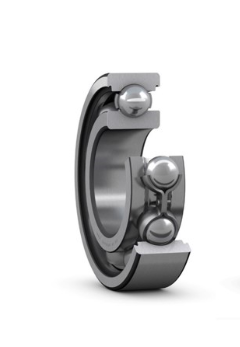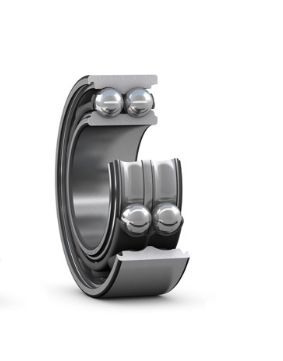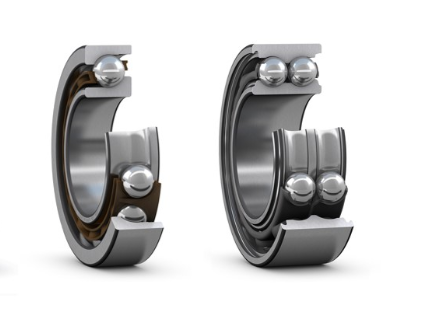Single Row vs. Double Row Deep Groove Ball Bearing
A deep groove ball bearing is a type of rolling-element bearing that is widely used to support radial and axial loads in various applications, consisting of four main components: an inner ring, an outer ring, a set of steel balls, and a cage to hold the balls in place. There are many types of deep groove ball bearings, but we only discuss their main classification—single row deep groove ball bearing and double row deep groove ball bearing here.
Single row deep groove ball bearings:
A single row deep groove ball bearing is a type of rolling-element bearing that only has a single row of balls positioned between the inner and outer rings. Here are the key characteristics of a ball bearing of single row:
- Structure: The single row type of bearing is designed with a deep, curved raceway on both the inner and outer rings. The balls are positioned within this raceway, which allows them to rotate freely and distribute the load evenly.
- Load Capacity: This kind of bearing can support both radial loads (forces acting perpendicular to the shaft) and axial loads (forces acting parallel to the shaft). However, their axial load capacity is limited compared to other types of bearings.
- Versatility: The deep groove ball bearing of single type is versatile and widely used in various applications, including electric motors, pumps, fans, conveyors, and automotive components. It is suitable for moderate load and speed conditions.
- Low Friction: The high speed ball bearing is designed to reduce friction between the rotating components, resulting in smooth operation and minimal energy loss.
- Size Range: This single deep groove ball bearing is available in various sizes to accommodate different shaft diameters and loads which are standardized bearings and come in metric and inch sizes.
- Lubrication: Proper lubrication is essential for the smooth functioning and longevity of a single deep groove ball bearing. Lubricants help reduce friction and wear between the balls, raceways, and other bearing components.
- Sealing Options: Single row deep groove ball bearing may be equipped with various sealing options to protect against contamination and retain lubrication. These options include metal shields (designated as ZZ) and rubber seals (designated as 2RS).

Single row deep groove ball bearings are widely used due to their simplicity, affordability, and versatility. They are suitable for applications with moderate loads and speeds. However, for applications requiring higher load capacities or increased axial load capabilities, double row deep groove ball bearings or other specialized bearing types may be more appropriate.
Double deep groove ball bearings:
A double row deep groove ball bearing is a type of rolling-element bearing that has two rows of balls positioned between the inner and outer rings. This configuration allows for increased load-carrying capacity compared to a single deep groove ball bearing. The followings are the key features of a double deep groove ball bearing:
- Structure: Similar to a single row deep groove ball bearing, a double one consists of an inner ring, an outer ring, a cage, and a set of steel balls. However, it has two rows of balls instead of one, arranged in a deep, curved raceway on each side of the bearing.
- Load Capacity: The double row design of deep groove ball bearing provides increased load-carrying capacity compared to single one. The two rows of balls distribute the load more evenly and can handle both radial and axial loads effectively.
- Axial Load Capability: This kind of double row bearing have a higher axial load capacity than single one. This makes it suitable for applications that experience significant axial loads, such as in gearboxes, conveyor systems, and machine tools.
- Size Range: Deep groove ball bearing of double row is available in various sizes to accommodate different shaft diameters and loads. The outer diameter of a double deep groove ball bearing is typically larger than that of a single deep groove ball bearing, due to the additional row of balls.
- Applications: Double row deep groove ball bearing is commonly used in applications that require higher load ratings and improved performance. It is utilized in industries such as automotive, mining, construction, agriculture, and heavy machinery.

It's worth noting that double row deep groove ball bearings may have limitations in terms of operating speeds and temperature ranges due to increased friction and heat generation caused by the higher number of balls. In such cases, other bearing types, such as angular contact ball bearings or tapered roller bearings, may be more suitable.
When selecting a double row deep groove ball bearing or any other bearing, it is important to consider factors such as load requirements, speed, operating conditions, and the specific application needs to ensure optimal performance and longevity. Consulting with us in bearing selection is recommended for complex or critical applications.
Differences between single deep groove ball bearings and double deep groove ball bearings:
- Number of Ball Rows: The most significant distinction between these two types of bearings is the number of rows of balls they have. The deep groove ball bearing of single row only has one row of balls positioned between the inner and outer rings, while the double row has two rows of balls, one on each side of the bearing.
- Load Capacity: Double deep groove ball bearings have a higher load-carrying capacity compared to single deep groove ball bearings. The additional row of balls in a double deep groove ball bearing allows for increased radial and axial load capacity, making them suitable for applications that require higher load ratings.
- Axial Load Capability: Double row deep groove ball bearing has a greater axial load capacity than the single type. The arrangement of two rows of balls enables them to handle higher axial loads in both directions.
- Outer Diameter: This double type of deep groove ball bearing typically has a larger outer diameter compared to a single one due to the additional row of balls. This size difference is important to consider when selecting bearings for specific applications.
- Operating Speed and Temperature: The single row deep groove ball bearing generally has higher operating speeds and temperature limits compared to the double one. The increased friction and heat generated by the additional row of balls in double row deep groove ball bearings can impose limitations on their speed and temperature capabilities.
- Application Suitability: The single row deep groove ball bearing is commonly used in a wide range of general-purpose applications where moderate loads and speeds are involved. While deep groove ball bearing of double row is preferred for applications requiring higher load ratings, increased axial load capacity, and improved performance.

When choosing between single and double row deep groove ball bearings, it is essential to consider the specific requirements of the application, such as load, speed, temperature, and available space. ATO.com can help you determine the most suitable option for a given application and you will find that it is an enjoyable shopping experience.

